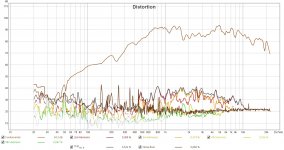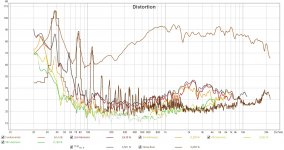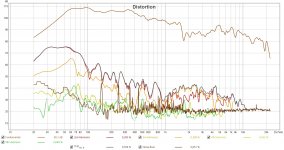Hi !
i got a question. i was wondering about measuring distortion of a multiway planar.
Nothing new to have a tweeter on the same foil, but usually that tweeter is located on de edge of the panel for obvious reasons ,
it does not move much there.
you can use magnets closer to the foil if needed.
easier to wire or foil coil wise.
it does not take much away in excursion capability
and it does not matter if that part does not play low end since it cant move there much to begin with
Now what if i mount my tweeter in the middle (since thats what i want) i might have the following problem, of the tweeter moving in and out the magnetic field when heavy bass is played in combination with content that the tweeter needs to cover. i have a few solutions that might solve that problem but firstly i want to measure the problem. so i can see what the results are.
Since REW plays a sweep the bass and the tweeter range never play at the same time , so measuring this setup i get a scewed distortion result. (or do i miss something) since
What i did today was playing a 38 hz sine on the total foil and performed a sweep on the tweeter. i had to use 2 different channels on my DSP or the thing went complete bananas (not sure what thats causing , i must add i did not check if i was clipping....) anyhow the second options works sort of.
But i wondered are there any other methods that can measure distortion in a different way to see the interaction of drivers combined ? that do not cover the same range
here few pics dont look at FR i just added 4 traces on there to act like tweeter.
Pic 1 Bass panel alone sweep
Pic 2 Tweeter alone sweep
Pic 3 Bass 38 hz sine wave and tweeter sweep at the same time
Now we can see distortion when playing a 38 hz tone increases distortion in the tweeter, FR response seems to be almost not affected.
Pic 4 Bass and tweeter same time sweeped
here we can see the way it is when both are measured at the same time by REW , they both perform almost the same as they would be when playing on there own separately. and does not give a good insight.
its hard to say what im looking at haha. might be that noise of whatever of playing 38hz (like mechanical influenced it as well)
i got a question. i was wondering about measuring distortion of a multiway planar.
Nothing new to have a tweeter on the same foil, but usually that tweeter is located on de edge of the panel for obvious reasons ,
it does not move much there.
you can use magnets closer to the foil if needed.
easier to wire or foil coil wise.
it does not take much away in excursion capability
and it does not matter if that part does not play low end since it cant move there much to begin with
Now what if i mount my tweeter in the middle (since thats what i want) i might have the following problem, of the tweeter moving in and out the magnetic field when heavy bass is played in combination with content that the tweeter needs to cover. i have a few solutions that might solve that problem but firstly i want to measure the problem. so i can see what the results are.
Since REW plays a sweep the bass and the tweeter range never play at the same time , so measuring this setup i get a scewed distortion result. (or do i miss something) since
What i did today was playing a 38 hz sine on the total foil and performed a sweep on the tweeter. i had to use 2 different channels on my DSP or the thing went complete bananas (not sure what thats causing , i must add i did not check if i was clipping....) anyhow the second options works sort of.
But i wondered are there any other methods that can measure distortion in a different way to see the interaction of drivers combined ? that do not cover the same range
here few pics dont look at FR i just added 4 traces on there to act like tweeter.
Pic 1 Bass panel alone sweep
Pic 2 Tweeter alone sweep
Pic 3 Bass 38 hz sine wave and tweeter sweep at the same time
Now we can see distortion when playing a 38 hz tone increases distortion in the tweeter, FR response seems to be almost not affected.
Pic 4 Bass and tweeter same time sweeped
here we can see the way it is when both are measured at the same time by REW , they both perform almost the same as they would be when playing on there own separately. and does not give a good insight.
its hard to say what im looking at haha. might be that noise of whatever of playing 38hz (like mechanical influenced it as well)
Attachments
Last edited:
I don't use REW, but according to the link below and your previous experiments, it should be feasible. I'm not sure how flexible it is in its settings though.
A standard intermodulation distortion (IMD) test is similar to what you were doing, but just uses 2 fixed tones (instead of sweeps). That makes seeing/measuring a little easier, but obviously only uses 2 discrete frequencies at a time. Swept intermodulation distortion testing is possible, but it's not something that's typically in less expensive test equipment.
RTA Window
"Intermodulation distortion
Intermodulation distortion results are only valid when the system being monitored is driven using REW's Dual Tone test signal. The signal can be generated live from the generator, or saved to a file and played back on the system being measured. If playing from file the generator must still be showing with the same signal selected so that REW knows what it should calculate.
The generator provides preset signals for SMPTE, DIN, CCIF and AES17-2015 intermodulation measurement signals and a 'Custom' option allowing a user-selected pair of frequencies at a 1:1 or 4:1 amplitude ratio. Signals at 1:1 ratio will begin to clip at -3.0 dBFS (with the View option Full scale sine rms is 0 dBFS selected, 3 dB lower otherwise). Signals at 4:1 ratio will clip at -1.8 dBFS."
A standard intermodulation distortion (IMD) test is similar to what you were doing, but just uses 2 fixed tones (instead of sweeps). That makes seeing/measuring a little easier, but obviously only uses 2 discrete frequencies at a time. Swept intermodulation distortion testing is possible, but it's not something that's typically in less expensive test equipment.
RTA Window
"Intermodulation distortion
Intermodulation distortion results are only valid when the system being monitored is driven using REW's Dual Tone test signal. The signal can be generated live from the generator, or saved to a file and played back on the system being measured. If playing from file the generator must still be showing with the same signal selected so that REW knows what it should calculate.
The generator provides preset signals for SMPTE, DIN, CCIF and AES17-2015 intermodulation measurement signals and a 'Custom' option allowing a user-selected pair of frequencies at a 1:1 or 4:1 amplitude ratio. Signals at 1:1 ratio will begin to clip at -3.0 dBFS (with the View option Full scale sine rms is 0 dBFS selected, 3 dB lower otherwise). Signals at 4:1 ratio will clip at -1.8 dBFS."
Last edited:
This link discusses IMD testing and shows some example plots.
Testing Loudspeakers: Which Measurements Matter, Part 2 | audioXpress
Testing Loudspeakers: Which Measurements Matter, Part 2 | audioXpress



